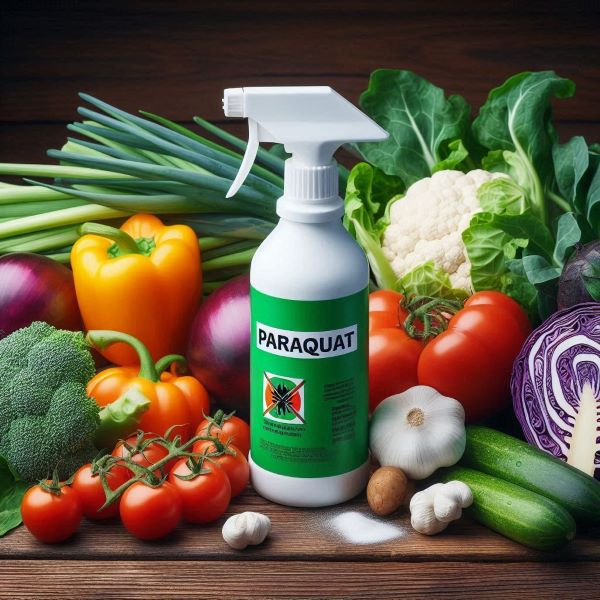Paraquat is one of the most widely used herbicides globally, known for its effectiveness in controlling weeds and unwanted vegetation. Despite its efficiency, it has garnered significant attention due to its high toxicity and associated risks to human health and the environment. This article delves into the details of Paraquat, including its description, usage, risks, and regulatory status in India and around the world.
What is Paraquat?
It is a fast-acting, non-selective herbicide used primarily for weed control in agricultural and non-agricultural settings. Chemically known as 1,1′-dimethyl-4,4′-bipyridinium dichloride, it works by producing reactive oxygen species that cause cell damage, leading to the rapid desiccation and death of plants. (Source)
Also, read: All You Need to Know about Methomyl, A Common Pesticide Used in Vegetables
Description and Usage
Description: It is available in various formulations, including solutions, granules, and powders. It is typically applied through spraying equipment, and its effects are visible within hours of application. (Source)
Usage: It is extensively used in various agricultural settings due to its broad-spectrum efficacy:
- Vegetables: Commonly used on crops like potatoes, onions, carrots, and tomatoes to control weeds and enhance crop yield.
- Fruits: Applied to fruit orchards, including bananas, citrus fruits, and grapes, to manage weeds.
- Field Crops: Widely used in the cultivation of crops such as maize, cotton, and sugarcane.
Risks to Human Health and Environment
Health Risks: It poses severe health risks, particularly with acute exposure:
- Acute Toxicity: It is highly toxic if ingested, inhaled, or comes into contact with the skin. Symptoms of acute poisoning include nausea, vomiting, abdominal pain, and potentially fatal respiratory failure.
- Chronic Exposure: Long-term exposure can lead to severe health conditions such as lung damage, kidney failure, and neurological disorders, including an increased risk of Parkinson’s disease.
- Fatal Poisoning: Due to its high toxicity, even small amounts of Paraquat can be lethal if ingested. (Source)
Environmental Risks: Paraquat also has significant environmental impacts:
- Water Contamination: It can contaminate water bodies through runoff, posing a threat to aquatic life and potentially entering the human water supply.
- Soil Health: Although it breaks down relatively quickly in soil, its repeated use can affect soil microorganisms, reducing soil fertility.
- Non-Target Species: Paraquat is toxic to non-target plants and animals, including beneficial insects, birds, and mammals, leading to ecological imbalances. (Source)
Paraquat Use in India
States and Crops: Paraquat is used across various states in India, with significant application in states like Punjab, Haryana, Maharashtra, and Tamil Nadu. It is particularly prevalent in the cultivation of vegetables such as potatoes and tomatoes, as well as in fruit orchards and field crops.
Regulatory Status in India: In India, Paraquat is regulated by the Central Insecticides Board and Registration Committee (CIBRC). While it is not banned, its use is subject to strict guidelines to mitigate risks to human health and the environment. Farmers are advised to follow proper application methods and safety protocols to minimize exposure and contamination. (Source)
Global Status of Paraquat
United States: The Environmental Protection Agency (EPA) regulates Paraquat under the Federal Insecticide, Fungicide, and Rodenticide Act (FIFRA). Its use is restricted, and it is classified as a restricted-use pesticide, meaning it can only be applied by certified applicators. (Source)
European Union: Paraquat is banned in the European Union due to its high toxicity and the risks it poses to human health and the environment.
Other Countries:
- Australia: Paraquat is registered for use but is heavily regulated to ensure safe application.
- Canada: The Pest Management Regulatory Agency (PMRA) oversees Paraquat use, with stringent guidelines to protect human health and the environment.
- Brazil: Paraquat is banned due to its high toxicity and associated risks.
Also, watch web stories: 7 Essential Health Tips for Monsoon
FAQs
1. Is Paraquat safe for household use?
- No, Paraquat is highly toxic and is not recommended for household use. It should only be applied by trained professionals in agricultural settings.
2. How can Paraquat exposure occur?
- Exposure can occur through ingestion, inhalation of sprayed droplets, and skin contact with treated plants or soil.
3. What are the symptoms of Paraquat poisoning?
- Symptoms include nausea, vomiting, abdominal pain, difficulty breathing, and potentially fatal respiratory failure in severe cases.
4. Are there safer alternatives to Paraquat?
- Yes, integrated pest management (IPM) strategies and the use of less toxic herbicides can provide effective weed control while reducing health and environmental risks.
5. Why is Paraquat controversial?
- Paraquat is controversial due to its high toxicity, potential health risks, and environmental impact, leading to stringent regulatory measures in many countries.





